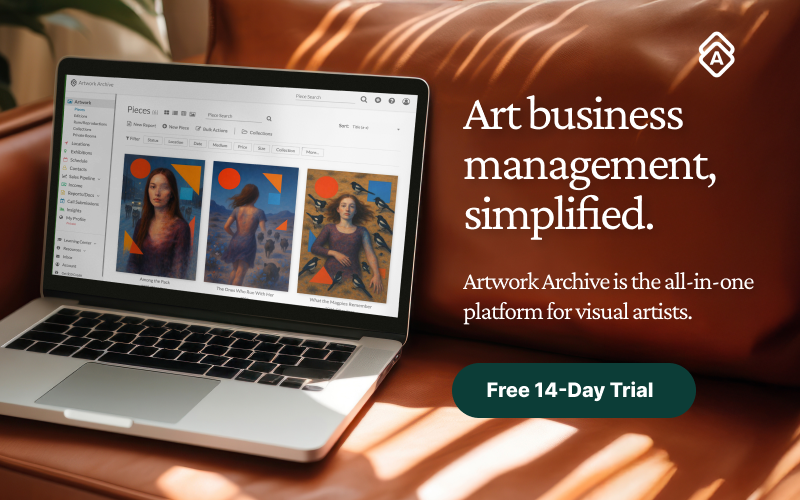Emily Hoerdemann, Memory Failure 113, Auction catalog, coloring book, magazine, and postcard on inkjet print, 11 x 14 in.
"Once a piece leaves my studio and goes to someone’s collection, these pieces of family history are also leaving my studio.”
There’s something both generous and harrowing about Emily Hoerdemann’s approach to art-making.
“A lot of my collage materials are from my own family," the collagist explains. "And rather than making copies, the original photographs, thread, cookbooks, sewing notions, and other materials are pasted on the page."
Like many artists, the Los Angeles-based collagist draws inspiration from her own family history. But she doesn’t stop there: she literally incorporates these scraps of her family’s past, piece by irreplaceable piece, into her complexly layered artworks.
That means that when collectors purchase her collages, they’re also becoming the caretakers of someone else’s intimate past.
In an in-depth conversation with Artwork Archive, Emily walks us through her practice and the ways her collages tackle themes of femininity, critiques of the American Dream, and even the ways the art market commodifies creativity. Working with materials ranging from family photo albums to her great grandmother’s cookbooks, Emily’s haunting compositions obscure faces, fragment bodies, and evoke the fragility of memory in a culture always ready to move on to the next thing.
Read on to learn how Emily Hoerdemann came to make collage her main medium, how her experience as an archivist has shaped how she organizes for her own art inventory, and how she handles the responsibility of being the custodian of her family’s material legacy.
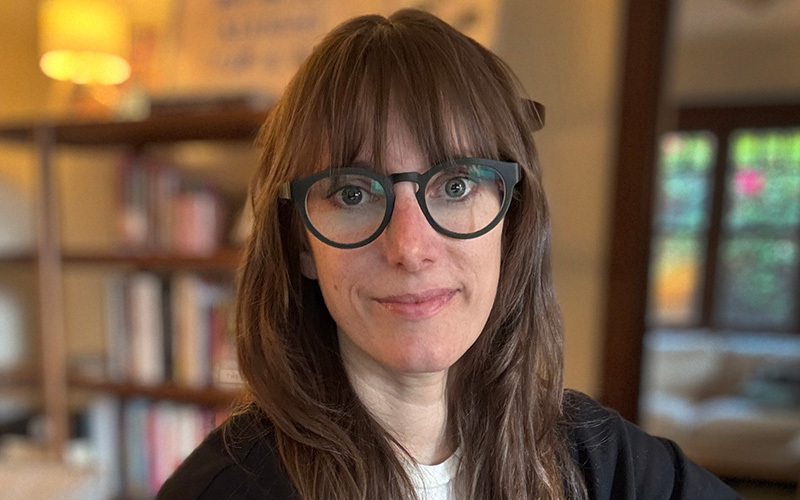 Emily Hoerdemann has found a unique way to combine her personal family archive with wider societal themes.
Emily Hoerdemann has found a unique way to combine her personal family archive with wider societal themes.
How Emily Found Her Art Medium
You wouldn’t know it by looking at her provocatively crafted artworks, but Emily didn’t start out as a collage artist. She initially treated collage as just another technique in her toolkit.
“I have been working with collage techniques since I can remember,” she told Artwork Archive, “but always looked at them as part of the painting or photograph I was working on.”
The shift happened gradually, while she was working on a series called Women Studies.
For that series, she began working smaller, cutting images from magazines and auction catalogs, and arranging them on paper. She overlaid these glamorous images of models, clothing, jewelry, and other markers of the media’s portrayal of women with thread, gouache, and stickers, to create pieces that seemed to stand on their own as collages.
After that series, Emily recalls, “my materials evolved from catalogs to vintage photographs and trinkets after I started archiving my own family photos.”
As she was finding her way in her medium, she started getting some unexpected inspiration from her family’s history. “My Mom started sending me boxes of photographs, embroidery thread that was my grandmother’s, cookbooks that were my great grandmother’s, and other bits and bobs that sparked my interest in this personal history of femininity,” she recounts. The experience also led her to explore more deeply "what other’s history of femininity meant.”
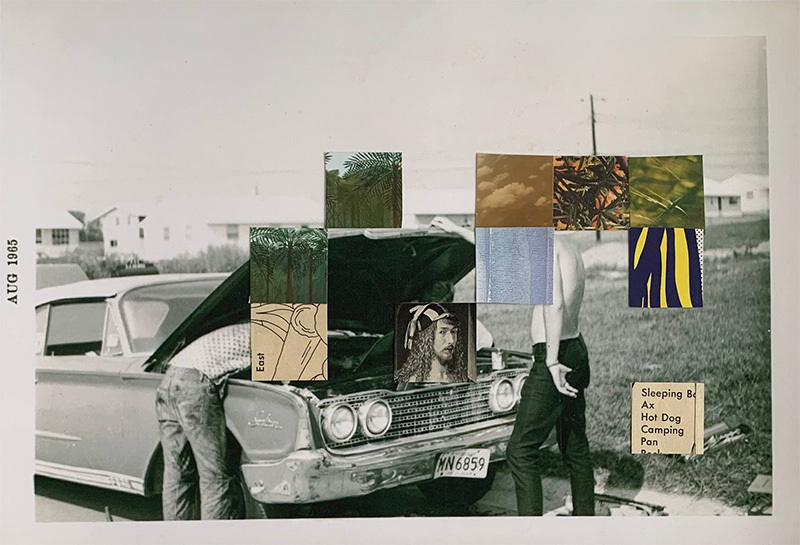 Emily Hoerdemann, Memory Failure 118, Auction catalog, coloring book, color photograph, encyclopedia brittanica, inkjet print, and magazine on inkjet print, 11 x 14 in.
Emily Hoerdemann, Memory Failure 118, Auction catalog, coloring book, color photograph, encyclopedia brittanica, inkjet print, and magazine on inkjet print, 11 x 14 in.
Creating Art Out of Experience and Memory
In her more recent collage work, Emily is particularly drawn to the physical and emotional realities of motherhood that often remain unspoken.
“A lot of what I’m exploring through my art is informed by my experience of becoming a mother,” she reveals. “From the physicality of pregnancy loss, the difficulties of pregnancy, birth, and the body postpartum.”
This focus on the physicality of embodied experience explains some of the more striking elements that recur throughout her work: the deliberate erasures and obscured identities in her collages. Faces disappear, bodies fragment, and what emerges is something more universal than individual portraiture, yet still fraught with emotion.
“The erasures first began as a way to separate identity from the body, making us view just femaleness-as-object,” she tells Artwork Archive. “Now I am also playing with the idea of memory, or how we remember something/someone/somewhere.”
Think of that family story that gets passed down and subtly altered through the generations, or the family photo with the mystery ancestor no one thought to identify in time. Emily’s haunting collages act as a visual metaphor for these fragments of what remain, the residues in the present of lives lived in the past.
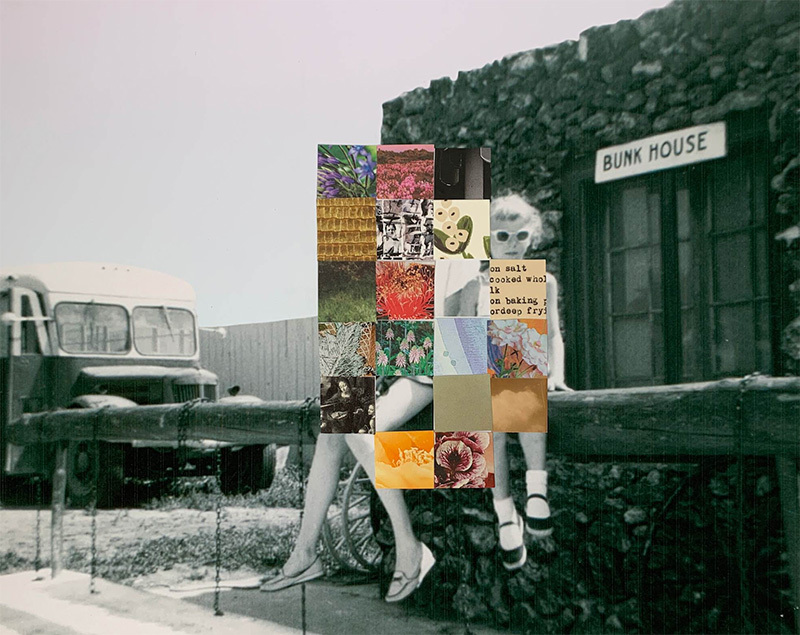 Emily Hoerdemann, Memory Failure 114, Auction catalog, color photograph, cookbook, encyclopedia, magazine, and postcard on inkjet print, 11 x 14 in
Emily Hoerdemann, Memory Failure 114, Auction catalog, color photograph, cookbook, encyclopedia, magazine, and postcard on inkjet print, 11 x 14 in
Committing Her Personal History to Art
Since so much thought goes into Emily’s pieces, she likes to fully prepare before she dives into the making.
“I tend to work in series, and I like to spend time researching the story that goes into those works,” she shares. “I fill my notebook with source text and inspiration sketches for what I plan on making, and then I set to work on the collages themselves.”
Not all of her pieces involve her own family’s archives. A look at her prodigious output will reveal source material as varied as vintage newspapers, Playboy covers, fashion magazine spreads, and found photographs. But when she does incorporate her own family’s materials into her artwork, she has a deep understanding of just how fragile and precious these materials really are.
Every time she commits an original family photograph to a collage, she’s making an irreversible decision. There’s no backup, no safety net, just the conviction that transforming these materials into art is her unique way of honoring them.
And after all that preparation, the work tends to just flow out of her: “Typically, I like to work on multiple collages at the same time, so the series comes out as a burst of several finished collages at once.”
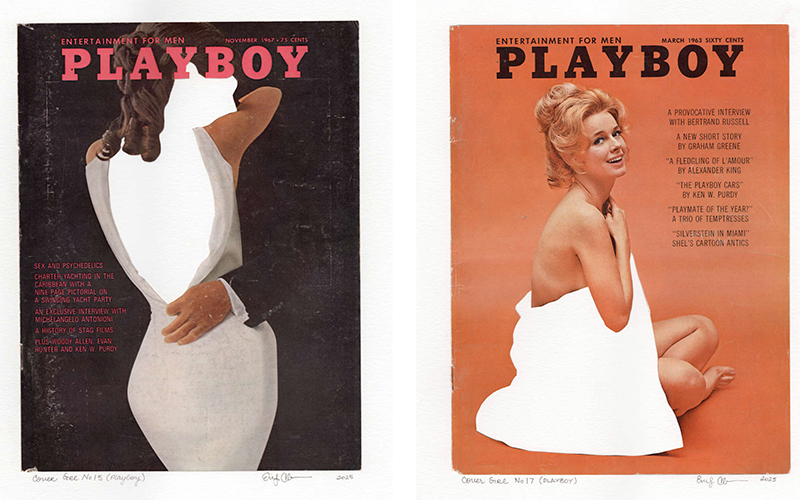 Emily Hoerdemann, Cover Girl No 15 (Playboy), Vintage 1967 Playboy magazine on watercolor paper, 14 x 11 in (left), and Cover Girl No 17 (Playboy), Vintage 1963 Playboy magazine on watercolor paper, 14 x 11 in.
Emily Hoerdemann, Cover Girl No 15 (Playboy), Vintage 1967 Playboy magazine on watercolor paper, 14 x 11 in (left), and Cover Girl No 17 (Playboy), Vintage 1963 Playboy magazine on watercolor paper, 14 x 11 in.
The Artist As Archivist
It makes sense that Emily has become the custodian of her family’s archives, since she is an archivist herself. With over a decade of experience creating digital organizational systems for the collections of museums, private art lovers, and artists themselves, she knows how important good record-keeping can be.
With her understanding of archival systems, she wanted to make sure she was giving the same care and attention to her own artistic inventory.
“The need to inventory my own artwork in a more sophisticated system didn’t seem urgent until I began working for a collector with an extensive collection of contemporary art,” she recalls. As she was tracking the condition and location of this collector's artwork, a lightbulb went off: the whole experience, she recounts, "made me realize I needed to update my spreadsheet to something more robust.”
She researched and reviewed art business systems that could be a good fit for her practice and her budget. One tool rose above the rest and was particularly appealing to her.
“I found Artwork Archive’s interface to be incredibly attractive,” she says. “The system was very intuitive, the pricing was affordable, and most importantly, the team was responsive to questions and suggestions.”
She signed up for Artwork Archive, started uploading her inventory, and has never looked back.
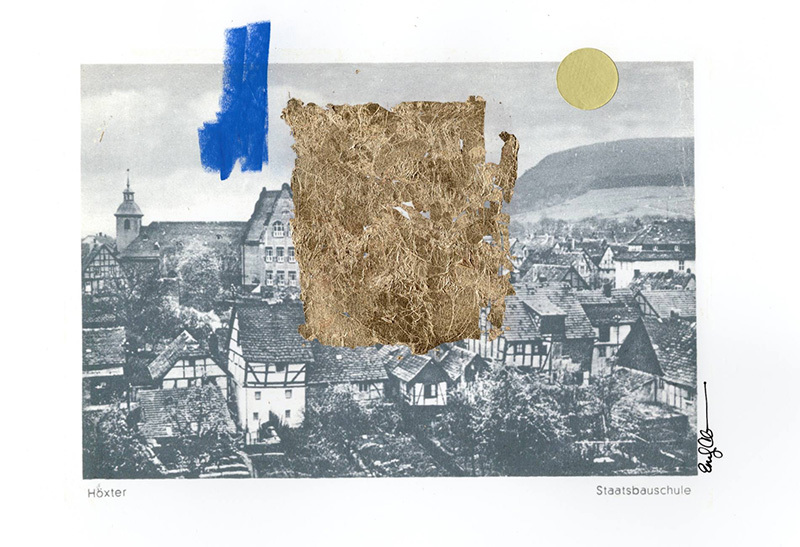 Emily Hoerdemann, Memory Failure III, Gold leaf, pastel, and sticker on pigment print, 8 x 10 in.
Emily Hoerdemann, Memory Failure III, Gold leaf, pastel, and sticker on pigment print, 8 x 10 in.
Gain a Bird’s Eye View of Your Art Practice
Emily’s process of working in series requires an organizational system that not only accommodates her approach to art-making, but enhances it.
That’s why her favorite feature in Artwork Archive is Collections. “When I utilize the Collections tab, I am easily able to reference any series as a whole, which is so nice as a visual person,” she explains.
If she looks at her inventory as a whole, “it can seem like the themes are a bit jumbled,” she admits. But using the Collections feature, Emily can see which of her projects share similar themes, which mark an exciting new departure in her art-making, and how her practice is growing over time.
The ability to see these connections as they build over time can help her think of her visual archive as interconnected explorations rather than isolated pieces.
How to Create Your First Collection:
What if organizing your artworks into discrete projects could be done in a matter of clicks? With Artwork Archive's Collections, it's that simple—give it a try today.
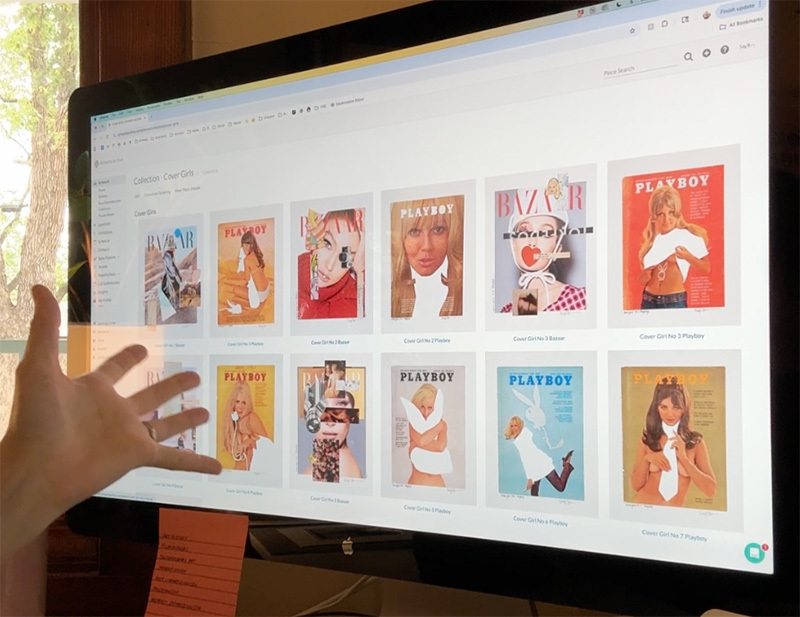 A peek inside Emily's collections.
A peek inside Emily's collections.
The Impact That Organization Can Have on Your Art Career
Emily’s advice for emerging artists reflects the lessons she has learned not only as a working artist but also as a professional archivist: “Getting organized from the start will empower you to be a better artist.”
Too many artists look at maintaining an inventory as a chore to be gotten through as quickly as possible. But Emily urges artists to see organization as a powerful way to become a better artist: “Being able to see your output, track and manage where your works are, and ultimately visually track your growth builds confidence.”
When artists can see their work patterns, understand their development over time, and trust their systems to handle the logistical side of their art career, they create the mental space they need to dive deeper into their creative exploration.
Don’t feel bad if you haven’t started your art inventory yet, though. Even with her background as an archivist, Emily also didn't start right away when it came to organizing her own work. The key for many artists, as it was for Emily, is to know when your current approach no longer serves your artistic ambitions, and to recognize when an upgrade in your art inventory arsenal will set you on the right trajectory.
If you're an artist struggling to balance creativity with business demands, Emily’s career provides a clear model. Her success demonstrates that far from constraining your artistic vision, proper organizational systems can actually liberate it.
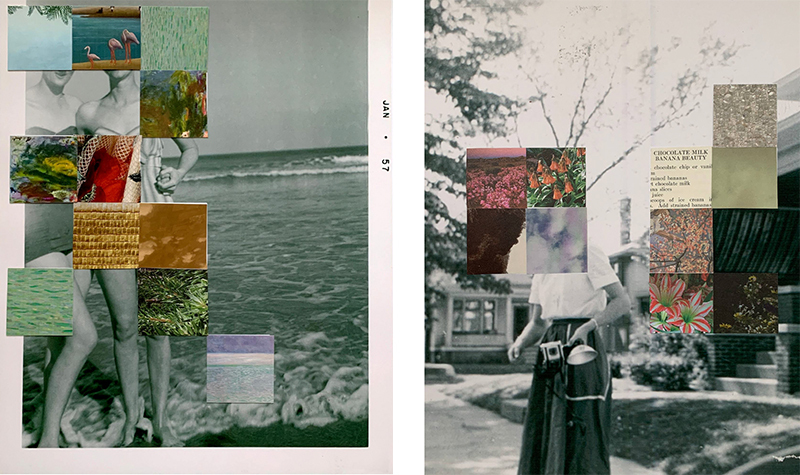 Emily Hoerdemann, Memory Failure 117, Auction catalog, color photograph, inkjet print, and magazine on inkjet print, 14 x 11 in (left), and Memory Failure 112, Auction catalog, cookbook, magazine, and postcard on inkjet print, 14 x 11 in.
Emily Hoerdemann, Memory Failure 117, Auction catalog, color photograph, inkjet print, and magazine on inkjet print, 14 x 11 in (left), and Memory Failure 112, Auction catalog, cookbook, magazine, and postcard on inkjet print, 14 x 11 in.
No matter where you are in your art journey, getting your business side in order doesn’t have to feel overwhelming. A bit of structure now can mean more time and headspace for the work you actually want to be doing.
Artwork Archive helps artists build an online portfolio, stay on top of their inventory, and create things like tear sheets and invoices in just a few clicks. Start a free trial and see how it fits into your own process.

